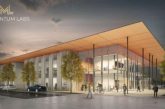
The University of Florida on Thursday received an $8 million federal award and was named one of six universities nationwide tapped to conduct high-performance computing simulations aimed at addressing some of the world’s most complex problems.
The award from the National Nuclear Security Administration and accompanying designation as a center of excellence is a direct result of UF’s drive to boost its high-performance computing abilities, said David Norton, UF vice president for research.
“It really leverages the investment the university made in high-performance computing and HiPerGator,” Norton said. “All of that was key in getting this award. This is exactly what we need in moving toward top-10 status.”
HiPerGator, UF’s supercomputer, became operational in May and is among the fastest and most powerful in the nation.
The primary focus of the centers of excellence will be on the emerging field of predictive science. The six universities were selected either as a Multidisciplinary Simulation Center, or MSC, or as a Single-Discipline Center, or SDC. The MSCs will receive $3.2 million and the SDCs will receive $1.6 million each year for five years under NNSA’s Predictive Science Academic Alliance Program II agreement. The six universities are:
- University of Florida, Gainesville, Fla., “Center for Compressible Multiphase Turbulence,” an SDC
- Stanford University, Stanford, Calif., “Predictive Simulations of Particle-laden Turbulence in a Radiation Environment,” an MSC
- University of Illinois-Urbana-Champaign, Champaign, Ill., “Center for Exascale Simulation of Plasma-Coupled Combustion,” an MSC
- University of Utah, Salt Lake City, Utah, “The Uncertainty Quantification-Predictive Multidisciplinary Simulation Center for High Efficiency Electric Power Generation with Carbon Capture,” an MSC
- Texas A&M University, College Station, Texas, “Center for Exascale Radiation Transport,” an SDC
- University of Notre Dame, Notre Dame, Ind., “Center for Shock Wave-processing of Advanced Reactive Materials,” an SDC
“The College of Engineering formed the Institute for Computational Engineering three years ago in order to help our faculty leverage the UF investment in high-performance computing and successfully compete for major multi-investigator grants. Under Dr. Balachandar’s leadership, the institute has done just that. This is a great step forward for interdisciplinary research at UF,” said UF engineering Dean Cammy Abernathy.
Predictive science is the application of verified and validated computational simulations to predict the behavior of complex systems where routine experiments are not feasible. The selected centers of excellence will focus on unclassified applications of interest to NNSA and its national laboratories – Lawrence Livermore National Laboratory, Los Alamos National Laboratory and Sandia National Laboratories.
The centers will develop the science and engineering models and software for their large-scale simulations using methods of verification and validation and uncertainty quantification, with an additional focus on extreme-scale computing. The goal of these disciplines is to enable scientists to make precise statements about the degree of confidence they have in their simulation-based predictions.
S. “Bala” Balachandar, the William F. Powers Professor of Mechanical and Aerospace Engineering, is the principal investigator for the award work at UF. He said his team’s research aims to help develop better understanding and computer models that ultimately could improve health and safety. For instance, he said, improved computer models could better predict how high a dust cloud will rise from a volcanic eruption, allowing airlines to re-route flights safely around it. In the case of a poisonous gas release, emergency officials could use enhanced models to create better evacuation plans. The same modeling could be applied to predict how a dust cloud from a meteor strike might move.
Balachandar said his modeling could even improve needleless drug delivery, which relies on injecting drugs through the skin via high pressure gas.
“Any problem that involves large numbers of particles and droplets moving quickly,” he said, “that’s what interests me.”
Validation of the computer models is the key, he said, and to that end his team will work closely with the NNSA laboratories and with partners at the Air Force Research Laboratory at Eglin Air Force Base in Florida.




